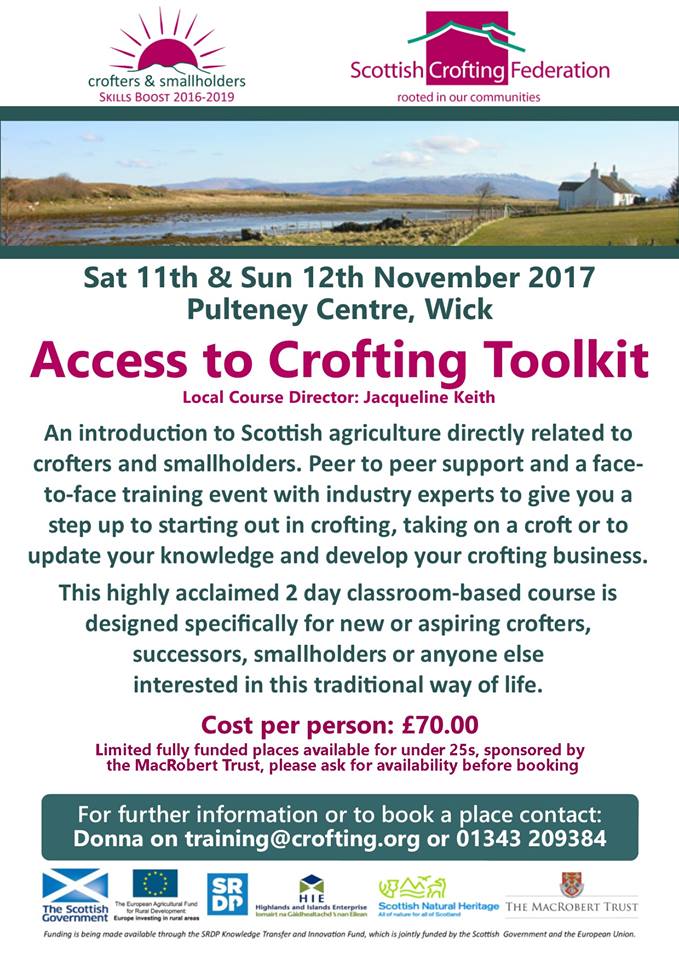Access to Crofting Toolkit - Wick

Pultneytown Centre, Wick, Caithness
Access to Crofting Toolkit – Learning Outcomes
General
Participants will be coming from a variety of backgrounds, some may be established crofters wishing to have an update – though in the main participants may be aspiring crofters, new entrants or successor crofters. No prior knowledge is assumed, nor required and there may be disparate knowledge bases within the cohort of students.
The aim of the weekend is to equip students with a good general knowledge in 5 themes that will give the student a greater general knowledge and signpost them to places where they may gain further knowledge or help if required. The themes are detailed in the following paragraphs.
All themes are based on the National Occupational standards which can be found here:
http://nos.ukces.org.uk/Pages/Search.aspx
Delivery
Prior to face to face interaction in classroom sessions students will be given access to some background course materials in a “flipped classroom” which will be administered by SCF as part of the enrolment process.
Educational studies suggest that allowing students access to a flipped classroom is a good way of digesting info so that face to face classroom time allows a deeper and more relevant level of student/tutor interaction.
THEME 1: EVALUATING AND AQUIRING A CROFT (Eilidh Ross)
Based on National Occupational Standards LANCSH1, LANCSH3
To equip any would be crofters or new crofters with a broad, basic knowledge of statutory functions and regulations relating to land acquisition, environmental pollution, planning and development.
To signpost people to the places where they can find crofts for sale, rent and register interest in a croft.
To give a grounding knowledge on the statutory and regulatory functions of the Crofting Commission.
Q and A session/types of problems that arise and how to deal with them
THEME 2: AGRICULTURAL SUBSIDIES, RECORD KEEPING AND RETURNS (Ruth Archer)
Based on National Occupational Standards BAB121 and BAB122
To gain an understanding of minimum holding size for IACS, CPH numbers, herd/flock numbers and where to register your holding. To understand IACS maps and when you require a land maintenance request form.
To equip any would be, or new entrant crofters with sufficient basic knowledge of how to prepare and make agricultural returns, applications and claims, and where to seek further advice or help if required.
Keeping records relating to land management (ferts/agri chemicals and pasture seeding), livestock records and movement of livestock (Cattle, Sheep, Pigs and Poultry) – (a very basic understanding of compliance requirements and what to expect at an inspection as this will be more detailed in livestock lecture)
Statutory compliance, GAEC, SMRs, Health, Safety and Environment. Raise awareness of the relationship between farming and the nature and landscapes and the impact of land-use changes on biodiversity, landscapes and recreation.
Q and A session/types of problems that arise and how to deal with them
THEME 3: CROFT LAND MANAGEMENT (Stephen Varwell)
Based on National Occupational Standards LANCS70, LANCSH3, LANEM15, LANAgM8
To identify the key characteristics of croft land use: topography, soil type, weather, different habitats (machair, in-bye, upland and hill systems)
To highlight practical considerations when setting up a croft business: land type, size, buildings, apportionments and common grazing accessibility. To develop an awareness of environmental best practice and a basic understanding of statutory environmental designations at a local, national and EU level and how these could affect croft and management and where to seek further advice or guidance. Encourage practices that improve the efficiency and resilience of farming systems whilst maintaining healthy ecosystems.
To understand habitat management and creation in a crofting context. Promote agri-environment measures that improve the relisilience of biodiversity to climate change.
Q and A session/types of problems that arise and how to deal with them
THEME 4: CROFT LIVESTOCK (Stephen Varwell)
Based on National Occupational Standards LANAgM3, LANAgM11, LANAgM12, LANAGM4,LANLP39, Administer Agricultural Records
To understand the theory of animal Welfare, the 5 animal freedoms and the safe handling and restraint of animals for movement and inspection.
An intro to breed characteristics in sheep, cattle, pigs and poultry, native vs non-native advantages and disadvantages, nutrition and suitability to a crofting system and the biodiversity of hill livestock systems on moorland.
To understand record keeping and timescales for births, movements and deaths (all species) and where to seek further info or advice.
Animal health, welfare and biosecurity and where to seek further advice and information.
Q and A session/types of problems that arise and how to deal with them
THEME 5: CROFTING HORTICULTURE AND AGRO FORESTRY (Maggie Sutherland)
Based on National Occupational Standards LANCSH3, LANCS32, LANH14, LANPH8
To understand the role of site selection, soil, topography and weather for horticulture and small scale woodlands and shelterbelts.
To understand the role of small scale forestry planting in crofting and agricultural systems, shelterbelts, habitat management and small scale silvicultural production. Refer to grants available and signpost for further info and advice from FCS and ruralpayments.org
Small scale tree planting, ground preparation and cropping maintenance. Timing, site suitability and species of trees. Harvesting, coppicing and natural re-gen.
To understand the role of field vegetable horticultural production, to understand the role of polytunnel production in a crofting context.
Plan and prepare the growing media, provision of nutrients for crops and plants: Composting, seaweeds, organic matter, provision of water for crops and plants.
Dealing with pests and disease silvicultural and horticultural.
Q and A